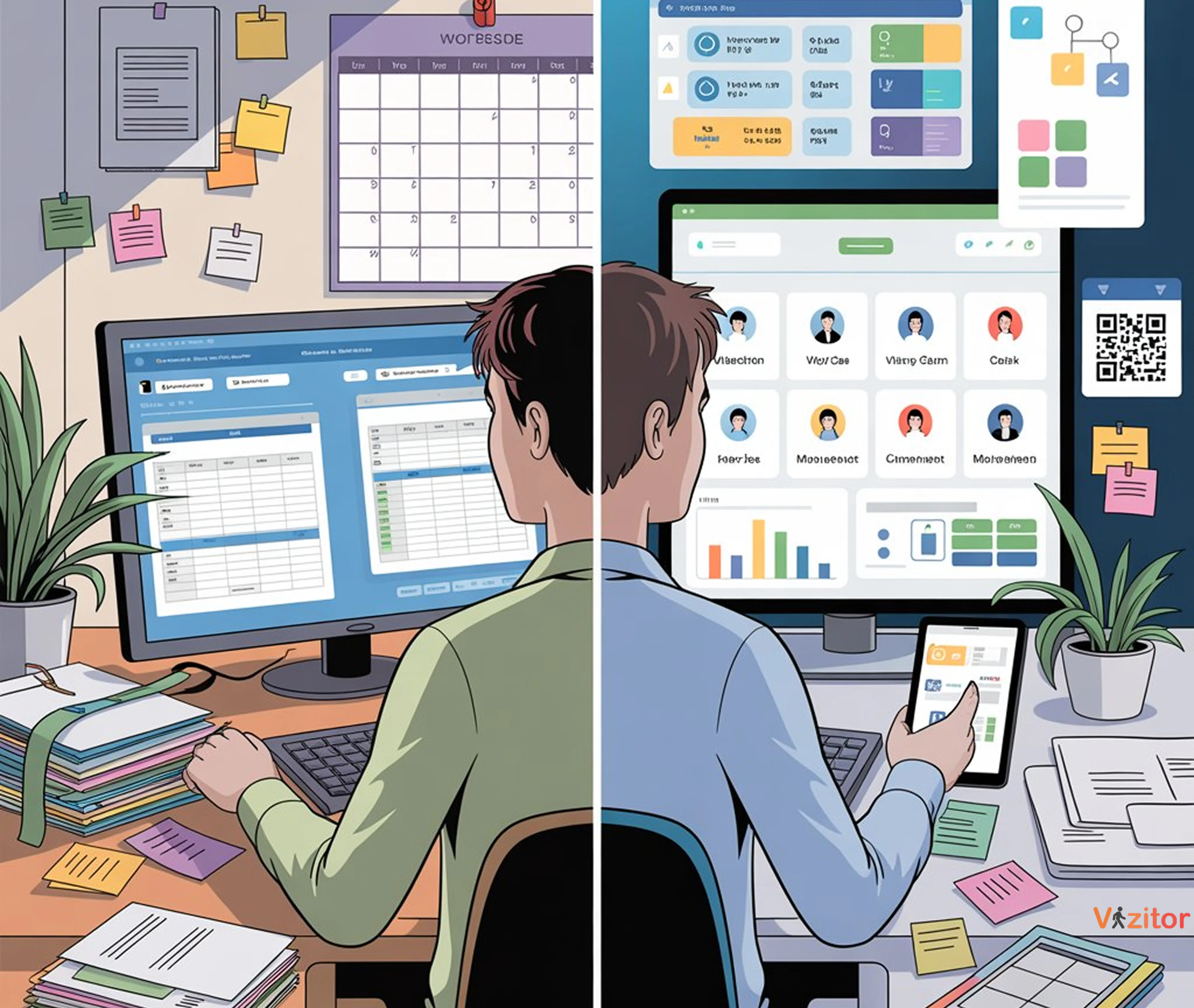How Workplace Management Software Boosts Productivity
The modern workplace is evolving and digital transformation is at its core. This blog explores how workplace management software and cloud-based workplace systems improve productivity and employee experience by automating routine tasks, optimizing space usage, and enabling seamless collaboration. From smart scheduling to data-driven insights, these tools empower hybrid teams to work efficiently and stay connected. With Vizitor’s workplace management system, organizations can simplify daily operations, enhance engagement, and build a future-ready, intelligent workplace.
Table of Content
Try Vizitor for Free!

Published on: Wed, Nov 5, 2025
Read in 5 minutes
Introduction: Why the Modern Workplace Needs to Be Smarter
The workplace has evolved dramatically in the last few years. Hybrid teams, remote collaboration, and flexible schedules have become the new normal but with these changes come new challenges in managing people, space, and productivity.
To stay efficient, organizations are turning to digital workplace solutions that go far beyond simple office software.
These platforms powered by automation, cloud technology, and real-time analytics helps companies streamline operations while improving employee satisfaction.
In this blog, we’ll explore how adopting workplace management systems and tools like Vizitor can transform your office into a connected, productive, and employee-centric environment.
1. What Is a Workplace Management System?
A workplace management system is an integrated platform that helps businesses manage spaces, employees, and resources efficiently.
Unlike traditional office tools, modern workplace management software connects multiple functions from meeting room booking and visitor management to attendance tracking and space analytics into one unified dashboard.
Core Features Include:
- Digital visitor check-ins via QR codes or tablets
- Smart meeting room scheduling
- Attendance and access control integration
- Real-time space utilization analytics
- Delivery and queue management
In short, a workplace management system gives organizations visibility, automation, and control over how work happens across teams and spaces.
2. Why Businesses Need Cloud-Based Workplace Management Software
A cloud-based workplace management system allows businesses to manage operations from anywhere whether employees are working on-site, hybrid, or fully remote.
Benefits of Going Cloud-Based:
- Real-time synchronization of data across devices and departments
- Instant software updates with zero downtime
- Scalability perfect for growing teams and multi-location offices
- Remote access for facility managers and HR teams
With cloud technology, companies eliminate the need for physical servers or local installations, reducing IT overhead while improving operational flexibility.
3. Key Benefits of Using Workplace Management Tools for Productivity
Productivity is not just about working harder, it’s about working smarter.
Workplace management tools automate repetitive tasks and reduce time wasted on manual coordination.
How These Tools Boost Productivity:
- Room booking and scheduling
- Streamlined visitor processing
- Centralized communication between departments
- Real-time analytics to identify workflow bottlenecks
According to a Study, organizations using integrated digital tools reported increase in team productivity compared to those using standalone systems.
4. Enhancing Employee Experience with the Best Workplace Management Solution
Happy employees are productive employees and the workplace management solutions understand that.
Modern workplace systems focus on improving daily employee experiences, from check-in to collaboration.
Employee Experience Enhancements:
- Easy room booking via mobile or desktop
- Quick access to digital badges and attendance logs
- Personalized notifications for meetings or deliveries
- Cleaner, safer, and better-organized workplaces
When employees feel supported by intuitive systems, they’re more engaged and motivated — directly impacting performance and retention.
5. How Cloud-Driven Workplace Management Systems Improve Collaboration
Collaboration is at the heart of productivity.
Cloud-driven workplace management systems ensure seamless teamwork even when employees work across locations or time zones.
Key Collaborative Features:
- Integrations
- Instant visibility into room and desk availability
- Automated notifications for meeting changes
- Centralized dashboards for shared visibility
By aligning people and processes through the cloud, workplace systems enable faster decisions, fewer conflicts, and smoother communication.
6. The Role of Workplace Analytics in Continuous Improvement
One of the biggest advantages of digital transformation is data-driven decision-making.
Workplace analytics tools track real-time usage data like room occupancy, visitor patterns, and meeting frequency; to help leaders make informed, measurable improvements.
Data Insights Enable:
- Smarter space planning and cost savings
- Energy efficiency optimization
- Predictive scheduling for hybrid teams
- Enhanced compliance and security reporting
With a solution like Vizitor, companies can turn raw workplace data into actionable intelligence, improving both employee experience and business outcomes.
7. Why Vizitor Is the Best Workplace Management Solution for Modern Offices
Vizitor stands out as a complete workplace management platform that combines automation, analytics, and ease of use.
Vizitor Helps You:
- Streamline visitor and meeting room management
- Automate tAttendance and access control
- Monitor space utilization and analytics
- Simplify delivery and queue management
- Support hybrid work with cloud accessibility
As a cloud-based workplace management system, Vizitor empowers teams to work efficiently while providing leaders with actionable insights to optimize every aspect of the office experience.
8. The Future of Productivity: Smart and Connected Workplaces
The future of work is digital, connected, and intelligent.
Companies that adopt smart workplace systems today will gain a competitive edge in productivity, sustainability, and employee satisfaction tomorrow.
As AI, IoT, and analytics converge, workplaces will become self-optimizing ecosystems learning from employee behaviors, predicting needs, and adapting dynamically.
Platforms like Vizitor are leading this transformation, helping organizations transition from managing offices to empowering intelligent workplaces.
Conclusion: Technology That Works for People
At the core of every productive workplace is technology that enables people to do their best work.
By integrating automation, analytics, and collaboration under one digital platform, workplace management software turns daily chaos into organized efficiency.
With Vizitor, businesses don’t just manage work, they reimagine it for a more connected, productive, and human workplace.
Bring productivity and experience together with Vizitor.
Try the Vizitor Workplace Management System today, the best workplace management solution for hybrid and modern offices.
FAQs
Q1. What is the main difference between a workplace management system and office software?
Office tools handle administrative tasks, while workplace management systems integrate automation, analytics, and space management for smarter operations.
Q2. How does a cloud-based workplace management system help hybrid teams?
It allows remote access, real-time data sync, and flexible scheduling; enabling collaboration across multiple locations and devices.
Q3. What makes Vizitor the best workplace management solution?
Vizitor combines visitor management, room booking, attendance, and analytics into one cloud-based platform for total workplace automation.
Q4. Are workplace management tools secure?
Yes, platforms like Vizitor use data encryption and access control to ensure privacy and compliance with global data protection standards.
Q5. Can small businesses benefit from workplace management software?
Absolutely, Vizitor’s scalable plans make it ideal for startups, SMBs, and enterprises looking to improve efficiency without heavy infrastructure








